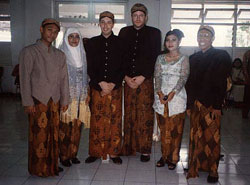Project Members
- Thomas J. Conners
- J. Joseph Errington (Yale University)
- Michael Ewing (University of Melbourne)
- Sander Adelaar (University of Melbourne)
- Zane Goebel (Nagoya University)
The Javanese Dialect Mapping Project

The Javanese dialect mapping project aimed to collect, document, and analyze various aspects of a number of Javanese dialects. Focus was given to in-depth, naturalistic speech recordings, with the addition of word lists and elicitations. As part of the project, we were ‘debunking’ the myth of a ‘standard’ Javanese, based on the Surakarta and Yogyakarta varieties.
Javanese as described in most grammars, dictionaries, and scholarly works refers to the varieties spoken in and around Surakarta and Yogyakarta. However, with over 100 million speakers, there is tremendous variation among sometimes non-mutually intelligible dialects of Javanese. Our project focused on these ‘non-standard’ dialects.
By focusing on these 'peripheral' languages, many unexpected patterns have emerged. For example it has become clear that in many respects, but particularly in terms of lexicon, phonology and morphosyntax, the 'standard' language is in many ways the most innovative, with different innovations radiating out from this center. Vowel raising and harmony provide an excellent example.
In Solo/Yogya Javanese, /a/ becomes /ɔ/ in word final position, so that lima 'five' is pronounced [limɔ]. A suffix will block vowel raising: lima-né 'the five of them' [lima-ne]. This vowel raising feeds vowel harmony, and there will be regressive assimilation of an /a/ vowel in an immediately preceding open syllable, for example, mata 'eye' is pronounced [mɔtɔ], but mata-né is [mata-ne].
Both vowel raising and vowel harmony are unknown in Old and Middle Javanese, and turn out to be innovations of the Solo/Yogya dialect. These changes have spread out and now affect many other dialects in Java. However, the geographically disconnected dialects of Banten, Pesisir Lor, Banyumasan, Tengger, and Osing all maintain the original pattern.
Following the International Symposium on the Languages of Java, organized through MPI EVA JFS, we were developing collaborative data collection projects with Yale University, Melbourne University, and other independent researchers. The local office has become a clearing house for data and recordings on Javanese dialects, available to all interested scholars.